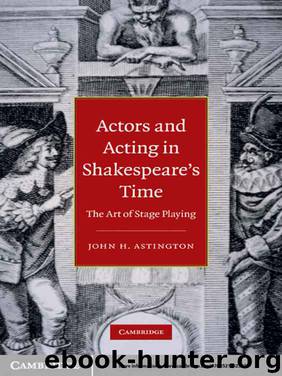Actors and Acting in Shakespeare's Time by John H. Astington

Author:John H. Astington [Astington, John H.]
Language: eng
Format: epub
Tags: Arts & Photography, Performing Arts, Theater, History & Criticism, Literature & Fiction, British & Irish, Dramas & Plays, Regional & Cultural, European, Drama & Plays, Criticism & Theory
ISBN: 0521192501
Amazon: B009XAGBPQ
Publisher: Cambridge University Press
Published: 2010-09-29T00:00:00+00:00
Chapter 5 Players at work
Have you the lion’s part written? Pray you, if it be, give it me, for I am slow of study.
Snug, A Midsummer Night’s Dream, 1.2.66–7
To prove his best, and if none here gainsay it,
The part he hath studied, and intends to play it.
Thomas Heywood, ‘The Prologue to the Stage, at the Cockpit’, The Jew of Malta (1633)
Studying one’s part preceded meeting for the full rehearsal of a given play, limited as the latter activity may have been in the English theatre of the sixteenth and seventeenth centuries.1 Extended rehearsal periods under the supervision of a director developed only in the later nineteeth-century theatre, and even then they were something of a luxury. Up to the middle of the last century actors in ‘weekly rep’, or even at the Stratford Memorial Theatre, did not see much rehearsal time: they were hired to play a range of parts in existing plays, and were expected to know the main framework into which they were to fit.2 Searching and original work on text and character simultaneously with attention to an ensemble style, overseen by one guiding artistic intelligence, the kind of approach practised at the Royal Shakespeare Company, for example, from about 1960 onwards, stems from such experimental nineteenth-century practice as that pioneered by the Duke of Saxe-Meiningen, and, notably, Konstantin Stanislavski. In establishing his Moscow Art Theatre and its acting studios, jointly with Nemirovich-Danchenko, and particularly in writing about his principles, Stanislavski became a modern master of theatrical practice, his teachings spreading especially to the United States as ‘the Method’.
Stanislavski’s writings about acting, it is as well to point out, do not say anything particularly new about the art, but rather describe what actors do, with certain kinds of attention to technique: the relationship between the player’s personal experience and the imagined experience of dramatic characters (Aeneas, or Hecuba, say), the invocation of emotion, and the discipline and control of the entire body, among other matters. Stanislavski himself was born to reasonable wealth and leisure, and cultivated a lively interest in amateur theatricals. His self-examination in his own acting – his dissatisfaction at failure, and will to improve – led him ever deeper into the theatre, both in practice and theory.
‘Study’, then, a common term for the individual preparation of players in Shakespeare’s day, is of some interest in the light of modern attitudes to rehearsal and to the ways in which an actor prepares. To study a part meant at its simplest to learn it, and its cues, by heart; Snug’s anxiety is that he will not have time to do this thoroughly enough to be a ‘perfect’ lion. To be perfect, at its simplest, meant that one said all one’s lines correctly and accurately (‘Ninus’ rather than ‘Ninny’), at the appropriate dramatic cues and in the right order: giving a cue was as important as receiving one. Bottom urges his companion actors to ‘Take pains, be perfit’ (A Midsummer Night’s Dream, 1.2.108–9); Costard in Love’s Labour’s Lost,
Download
This site does not store any files on its server. We only index and link to content provided by other sites. Please contact the content providers to delete copyright contents if any and email us, we'll remove relevant links or contents immediately.
| African | Asian |
| Australian & Oceanian | Canadian |
| Caribbean & Latin American | European |
| Jewish | Middle Eastern |
| Russian | United States |
4 3 2 1: A Novel by Paul Auster(11250)
The handmaid's tale by Margaret Atwood(6999)
Giovanni's Room by James Baldwin(6132)
Big Magic: Creative Living Beyond Fear by Elizabeth Gilbert(4896)
Asking the Right Questions: A Guide to Critical Thinking by M. Neil Browne & Stuart M. Keeley(4763)
On Writing A Memoir of the Craft by Stephen King(4338)
Ego Is the Enemy by Ryan Holiday(4268)
Ken Follett - World without end by Ken Follett(4091)
The Body: A Guide for Occupants by Bill Bryson(4044)
Bluets by Maggie Nelson(3876)
Adulting by Kelly Williams Brown(3791)
Guilty Pleasures by Laurell K Hamilton(3729)
Eat That Frog! by Brian Tracy(3678)
White Noise - A Novel by Don DeLillo(3533)
The Poetry of Pablo Neruda by Pablo Neruda(3471)
Alive: The Story of the Andes Survivors by Piers Paul Read(3403)
The Book of Joy by Dalai Lama(3344)
The Bookshop by Penelope Fitzgerald(3337)
Fingerprints of the Gods by Graham Hancock(3326)
